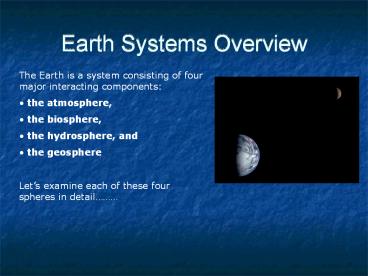Earth Systems Overview PowerPoint PPT Presentation
1 / 16
Title: Earth Systems Overview
1
Earth Systems Overview
- The Earth is a system consisting of four major
interacting components - the atmosphere,
- the biosphere,
- the hydrosphere, and
- the geosphere
- Lets examine each of these four spheres in
detail
2
Earth Systems Overview
TEK Define and identify the components of the
geosphere, hydrosphere, cryosphere, atmosphere
and biosphere and the interactions among them
(cycles).
3
Lithosphere
- The upper solid surface of the earth, which is
made of rocks, is called the lithosphere. - Its depth is not the same everywhere. It is
thinnest below the oceans and thickest below the
continents. - It has two layers, i.e. ,SIAL and SIMA.
- It is broken into 10 large rigid plates.
Movements of the lithosphere plates results in
the formation of deep sea, trenches, mountain
ranges as well as earthquakes.
4
Atmosphere
- A thin layer of odourless, tasteless , colourless
gasses surrounding the earth is called
atmosphere. - It is essential not only for man ,but for all
forms of life as it acts like a blanket in
controlling heat coming from the sun. - It is a mixture of many gasses like Nitrogen
-78.03,Oxygen- 20.99, Argon-0.93, Carbon
dioxide-0.03etc. - Besides hydrogen,neon,helium,ozoneetc. Are also
found. - It also contains water vapour, dust particles,
smoke particles ,salt particles etc. - The atmosphere is divided into the following
layers
5
The Atmosphere
- The Earth is surrounded by a blanket of air,
which we call the atmosphere. - The atmosphere consists of four unique layers
(the troposphere, the stratosphere, the
mesosphere, and the thermosphere). - The atmosphere reaches over 350 miles up from
the surface of the Earth. - The atmosphere is primarily composed of nitrogen
(about 78) and oxygen (about 21). Other
components exist in small quantities.
6
Hydro sphere
- Hydro sphere
- The hydrosphere literally means all the water
of all earth. It consists of both the relatively
shallow layer of water which covers about three
quarters of the earth surface, forming the
oceans, seas, lakes, ice sheets etc. - The oceans covering 71of the earth surface,
hold 97of all the earths water. - About 75of the total fresh water is locked up
in glaciers and ice sheets.
7
Hydrosphere
- The hydrosphere contains all the water found on
our planet. - Surface Water Includes the ocean as well as
water from lakes, rivers and creeks. - Ground Water Includes water trapped in the soil
and groundwater. - Atmosphere water vapor.
- Frozen water Includes ice caps and glaciers.
Specifically called the cryosphere. - Only about 3 of the water on Earth is fresh
water, and about 70 of the fresh water is frozen
in the form of glacial ice. (0.9 in liquid form)
8
Biosphere
- Biosphere is that portion of the earth which is
occupied by various forms of life. - It is an intricately interlocked system ,which
contains all that is needed for life,all that is
available for life and all that ever will be
available. - The total thickness of the biosphere is only
about 24kms.Vertically it only extends as high as
the tops of the tallest trees. - The ingredients of the biosphere are constantly
recycled and renewed in nature. - It is a kind of link between the other spheres of
the earth. Without it the earth would be a
sterile planet and human life and human
activities would not exists.
9
The Biosphere
- The biosphere is the life zone of the Earth,
and includes all living organisms (including
humans), and all organic matter that has not yet
decomposed. - The biosphere is structured into a hierarchy
known as a food chain. - Energy and nutrients, like carbon, are
transferred from one level of the food chain to
the next.
10
- EXOSPHERE - 600km and above
- IONOSPHERE- 80-600 km gt ionization takes
place, - reflecting
radio waves - MESOPAUSE- upper limit of mesosphere
- MESOSPHERE- 50-80 km gt ozone gas is found,
absorbs - ultraviolet rays
- STRATOPAUSAE- upper limit of stratosphere
- STRATOSPHERE- 12-50km gt aircraft moves, mother of
pearl - clouds
- TROPOPAUSE - upper boundary is tropopause,
- TROPOSPHERE- 0-12kmgtrain ,fog, mist ,hail
etc. take place
11
Geosphere
- The geosphere is the solid part of the earth,
from the core to the surface. - Includes volcanoes, rocks, minerals, coal, oil
etc. - Mineral resources are mined from the geosphere.
12
Earth System Science
Earth System Science is the study of how the four
spheres of the Earth system interact continually,
each affecting the others.
Example A scientist that studies global warming
is an Earth System Scientist.
13
System Interactions
Volcanoes (Lithosphere) erupt, sending ash and
gases into the air (atmosphere) and sending lava
and ash down onto surrounding forests (biosphere)
and human habitations (biosphere).
Lithosphere
Atmosphere
Biosphere
14
System Interactions
Hurricanes (atmosphere) sweep across the ocean
(hydrosphere) and onto the land (geosphere),
damaging the dwellings of people (biosphere) who
live along the coast.
Hydrosphere
Lithosphere
Atmosphere
Biosphere
15
System Interactions
Earthquakes (geosphere) can damage buildings
which may kill people (biosphere), as well as
cause fires which release gases into the air
(atmosphere). Earthquakes in the ocean may cause
a tsunami (hydrosphere) which can eventually hit
land and kill both animals and people (biosphere).
Biosphere
Lithosphere
Atmosphere
Hydrosphere
16
CFA
1. Name the four main earth systems.
Atmosphere, Biosphere, Hydrosphere and Lithosphere
2. Which branch of science studies the
interactions between these earth systems?
Earth System Science Example is a scientist that
studies global warming.
3. A forest fire would effect which earth systems?
All four Fires (Biosphere) will destroy plant
and animal life while releasing smoke and other
contaminants into the atmosphere, hydrosphere and
geosphere.

